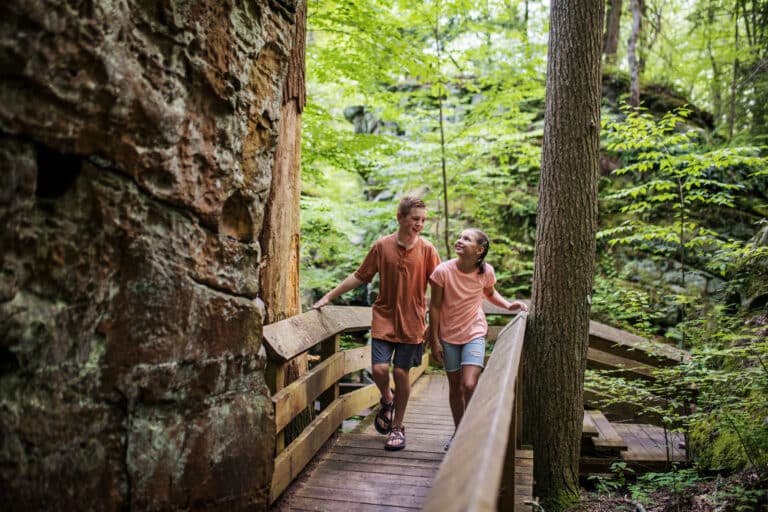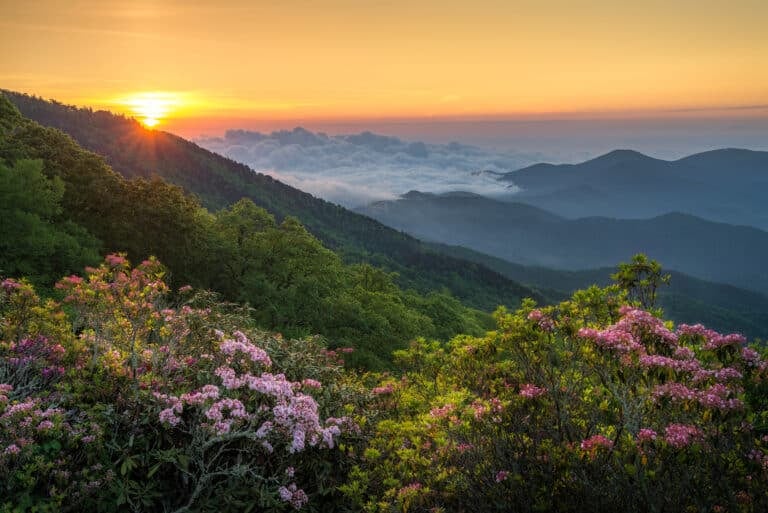Boone climbers saved Grandmother Mountain from development—and opened their secret crags to the masses.
Grandmother Mountain has no guidebook. It appears on only a few maps. Yet it is one of the premier bouldering destinations in the country.
First discovered in the mid-1990s near Boone, N.C., the area now hosts more than 400 problems and some of the best stone in the entire Southeast, all in a stunningly beautiful and cool sub-alpine forest.
The area has a reputation for being a locals-only area, but that’s changing thanks to the grassroots efforts of climbers themselves.
They have carved out a world-class climbing area from the thick vegetation and mossy boulders, uncovering some of the High Country’s most high-quality stone.

It all began fifteen years ago, when a small group of Boone climbers discovered an isolated cluster of boulders in a privately owned area called the Grotto. They cut unofficial trails to the rock, which became the cornerstone of the emerging bouldering community in the High Country.
A few years later, construction of a high-end gated subdivision began just above the Grotto, toppling the Grotto’s boulders and ripping through the forest.
“The Grotto is now somebody’s backyard—somebody who I’m sure doesn’t appreciate it at all like we did,” says Dan Smathers, who had begun filming at the Grotto for a class he was taking at Appalachian State University. Smathers’ video project eventually grew into Witness This, the definitive documentary of Boone bouldering.
The destruction of the Grotto was a staggering blow to the climbers, but it also pushed them to look for new boulders. Hidden deep in the lush forests of Grandmother Mountain were hundreds of other boulders perfectly suited for climbing. Dean Melton, one of the Boone bouldering pioneers, recalls discovering an endless stretch of overhanging rock that became known as Long Wall.
“It was quite the rush to see that and just to know that there was just a ton more stuff to play on,” says Melton.
Melton, Smathers, and a small group of climbers began constructing an expanded network of trails on Grandmother.
“If we had any issues with the rhododendron that we had to kill, or with the moss that we were removing, we couldn’t help but look around at the commercial impact that was happening with the gated communities’ bulldozers,” Smathers said.
Shortly after the road was constructed through the Grotto in 1999, the North Carolina Department of Transportation acquired the privately owned Grandmother Mountain from the owners in order to protect the area’s diverse ecosystems from future development. In the purchase agreement, the state agreed to allow the construction of 12 homes on the backside of Grandmother Mountain, but would preserve the rest of the mountain.

The protection of Grandmother Mountain became one of the first success stories in the often tumultuous process of bouldering around Boone. Before securing Grandmother, climbers in the High Country would discover an area, get to work cleaning and climbing, then arrive one day to “No Trespassing” signs and an angry landowner with strong words and a big gun. Such was the case with Howard’s Knob, a bouldering area nestled high atop a rocky knoll above Boone. The area was shut down by the landowner who had put the land up for sale. Climbers organized and worked to raise money to purchase the area from the landowner, but their lofty aspirations fell short, and the area remains closed to this day.
The purchase of Grandmother Mountain was the climactic moment in Witness This. Due to the secretive nature of climbing in the area, the film was met with trepidation by some climbers. They worried that the film would bring an influx of new climbers who would jeopardize their access to hard-won bouldering sites. At the film’s screening in downtown Boone, a handful of protesters gathered outside the venue—but ended up watching the video through the windows.
“After the screening, once people actually saw what the film was about, I didn’t hear a negative word about it,” says Smathers.
Still, Smathers decided not to release the video commercially out of respect for local climbers’ concerns. However, a special tenth anniversary edition of Witness This is scheduled to be released next year.
These days, most Boone climbers—including Melton and Smathers—are happy to share their once-secret crags with a larger community. They believe it was inevitable that people would find out about Grandmother Mountain.
“It’s now public land,” says Melton. “If you want to rock climb on it, go rock climb on it. I have traveled to other places to climb, so what right do I have to complain about other people who come here?”
Melton hopes Grandmother Mountain’s bouldering scene will draw more people out of the climbing gyms. He believes that some of the original beauty of bouldering has been lost in the modern gym setting where people learn to climb in an unnatural setting, for reasons other than the feeling of being out in nature, moving over stone.
“It’s good that gyms get people climbing who don’t have access to natural stone,” Melton says. “But the sad part about gyms is that it kind of takes some of the soul away from the boulder problems. It just becomes a pissing contest.”
Melton thinks places like Grandmother are essential for keeping alive the spirit and joy of bouldering.
“The most important part of bouldering is being outdoors with friends doing something that you enjoy. The natural beauty of the boulders and the setting is an essential part of the experience. If you lose sight of that, you’re probably taking it too seriously.”
For Smathers, the early days of climbing at Grandmother Mountain are some of the most memorable experiences of his life. “I’m just really happy to see that that mountain is still being climbed every day, and I’m proud to have played a small part in protecting it.” •
Eric Crews is a freelance writer and videographer who has spent his fair share of afternoons out at Grandmother Mountain.







